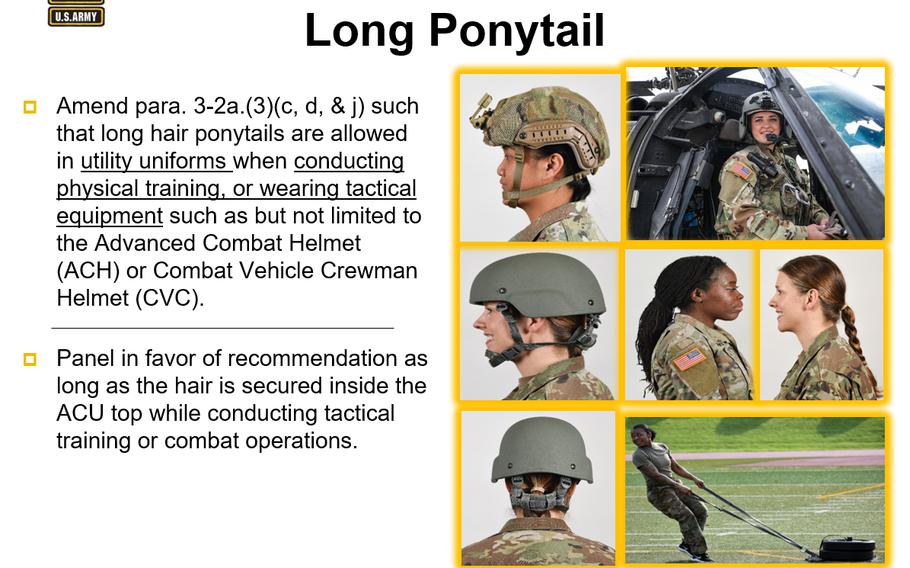Your Guide to Army Grooming Standards Including Latest Changes
Table Of Content

The panel was made up of 10 Black women, four white women, one Hispanic woman, one Hispanic man and one Black man. Now, the National Guard Bureau action officer is the face of the updated regulation, pictured wearing a formerly unauthorized hairstyle that was approved largely due to her persistent efforts. Among the revisions that will be included in the new AR — last updated in 2017 — include changes that have already been announced such as the Army Green Service Uniform and the Expert Soldier Badge. The U.S. Army is scheduled to enact a series of changes to its universal grooming standards on February 25. The move, which marks a substantial deviation from the Army's previous grooming code, is intended to improve the wellbeing of all Soldiers while incorporating such key themes as diversity and inclusion. U.S. Army hair regulations and grooming standards are comparable to other branches of the Armed Forces.
Army Grooming Standards: Haircuts, Mustaches, Beards, And More
Previous hair regulations disproportionately impacted soldiers with textured hair, including women of color. The revisions also removes potentially offensive language used to describe several hairstyles and replaces with appropriate terminology for unauthorized grooming and appearance standards. Leadership at all levels is responsible for enforcing the army hair policy. All soldiers will comply with hair, fingernail, and grooming policies in military uniform or civilian clothes on duty.
Army Nail Regulations
Let down your hair: New Army rules for ponytails, nail color - The Associated Press
Let down your hair: New Army rules for ponytails, nail color.
Posted: Tue, 26 Jan 2021 08:00:00 GMT [source]
The push to change the Army's grooming standards proves that the force is evolving and making a concerted effort to make everyone feel included, said Master Sgt. Quintana Mitchell, the uniform policy NCO for G-1. If the headgear does not fit the intended shape or has excessive gaps, female soldiers will be expected to conform their haircut to acceptable standards immediately. In 2015, the Army updated its tattoo policies to open the ranks to the 41% of millennials with at least one tattoo. The newest regulations give women greater freedom to choose hairstyles previously banned by the Army.
Army Hair Regulations
"It's been a very freeing change within the regulation," Campbell says. Completely shaved heads used to be against the rules that required hair to be at least 1/4 inch long. Dreadlocks, for instance, has ties to the American slavery experience, and will be replaced with “locs,” primer slides shared with reporters read. Still, many of the changes are geared towards women, and that’s intentional. “One thing we can never forget is that at the end of the day, our women are mothers, are spouses, are sisters — they definitely want to be able to maintain their identity, and that’s what we want to get after,” Sanders said. "I think we're making a lot of progress in the Army with these new standards," said USAMRDC Command Sergeant Major Victor Laragione.
Though there has been recent talk of loosening beard policy, the Army has not yet revised its longstanding policies banning beards and restricting mustaches as of the latest round of updates. According to an information paper posted by Deputy Chief of Staff for Personnel Lt. Gen. Gary Brito’s office, the update is part of the Army’s efforts to promote diversity and inclusion. The updates reflect the Army’s commitment to fostering an environment that promotes and facilitates diversity, equity, and inclusion. Inclusive policies foster the ability to recruit and retain the top talent. Army uniforms embody the professionalism and commitment to the Army Values. Long hair must be “neatly and inconspicuously fastened or pinned above the lower edge of the collar,” according to the regulations.
Tattoo Policy
There are a variety of options available to help you pursue education with flexibility, such as ROTC programs, the GI Bill, and other programs that help pay for college tuition, trade school, technical school, or trainings. Army ROTC has several scholarships available for college-bound high school students. Review your options at ROTC Scholarships, or immediately apply by creating an account at my.goarmy.com to get started. The slides go on to list the psychological impacts of hair loss and how a person’s quality of life is impacted by something like TA which can result in additional challenges like anxiety, depression, and poor body image.
Army Grooming Standards and AR 670-1
Bold colors such as purple, blue, pink, green, orange, bright red and neon colors are still not permitted. Approved hairstyle changes include no minimum hair length for female Soldiers, allowing multiple hairstyles at once (i.e. braiding, twists or locs). Soldiers will be able to wear ponytails if unable to form a bun, and may wear long ponytails while conducting physical training, in the combat uniform or when female Soldiers wear equipment such as, but not limited to, combat helmets.
Haircuts & Hairstyles
The effort originated from a panel of 17 Soldiers who were tasked with assessing a list of proposed changes relating to health, wellness, and professional appearance, among other factors. Included among the panel members was Sergeant Major Jennifer Redding of the U.S. Army Medical Research and Development Command's U.S. Army Institute of Surgical Research. The final, approved changes to the code were then officially announced by Sergeant Major of the Army Michael Grinston during a town hall-style meeting held via Facebook Live on January 26. The accessory must also be plain or a color similar to the natural hair color of the female soldier. A recent update to grooming standards is the removal of female members having to observe a minimum length of 1/4 inch from the scalp.

Army Nears Launch Date for New Grooming, Appearance Standards
This cut allows for more style while still adhering to regulations. The military crew cut haircut involves a slightly longer length on top that gradually tapers down to a shorter length on the sides and back. The Army Haircut Regulations apply to both men and women, though there are specific rules for each gender. “This is not just about hair, it’s about acknowledgement of personal rights, it’s about checking bias," California State Sen. Holly Mitchell previously told USA TODAY. “Some male Soldiers in certain occupation specialties rely on their hands, which are under constant bombardment while working with tools or harsh chemicals,” Sanders said. “A male Soldier would take this opportunity to keep their nails protected."
Highlights also can’t be unnatural colors, such as purple, blue, green, pink, bright red, fluorescent or neon. Women must wear braids and ponytails down the center of their backs. Braids and ponytails can not extend past the bottom of their shoulder blades when standing at attention. You can serve part-time as a Soldier in the Army Reserve or the Army National Guard.
It’s a safe and convenient alternative to expensive visits to a laser tattoo removal professional service. Sideburns, on the other hand, are allowed with certain specifications. The only exception is when granted a medical or religious waiver by the U.S. Mustaches must look neatly trimmed, tapered, and tidy at all times.
However, there is some more leeway granted for female authorized hairstyles within the Army. Male soldiers are not permitted to wear cornrows, braids, twists, and locks in uniform or when on duty. If wearing the APFU as a complete uniform, retirees must abide by the standards of AR 670-1, but they can add approved retired shoulder-sleeve insignia and identification badges. Soldiers with religious accommodations can grow their mustaches to connect with their beards, but they must trim or groom mustaches to keep them above upper lip lines.
According to Redding, the 17-person panel — of which 15 members were women — met for a total of three days to review and assess potential uniform changes. Panel membership further included a psychologist, a dermatologist and a number of additional dedicated subject matter experts. Suggestions were then submitted to senior leadership for approval. Wigs are also authorized so long as they look natural and once again conform to standard hair regulations. Female hair regulations in the Army are observed in order to maintain uniformity. Thus, U.S. Army hair regulations, facial hair, and other accessories (makeup, fingernails, etc) are considered daily essentials in order to maintain a high-functioning, well-disciplined unit.
Teresa Tennyson is a retired army officer who served in several countries in the Middle East. As an Arabic lingual and cultural specialist, her assignments included combat deployments and a diplomatic tour. Veterans with wartime service who were honorably discharged can also wear uniforms, according to Paragraph 23-4 of AR 670-1. The regulations restrict ceremonial attire to service and dress uniforms only.
"I use the analogy, 'If you look good, you feel good -- and if you feel good, you perform [well]," Sanders said. "If I am in the Army long enough, it would be nice to see how these changes have improved productivity ... and make Soldiers perform better." "This is one of the many facets of putting our people first and recognizing who they are as human beings," he said.
Comments
Post a Comment